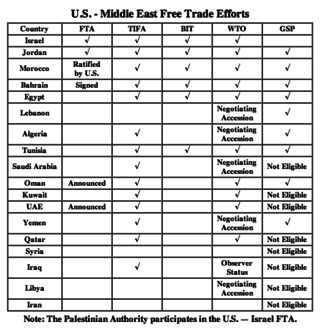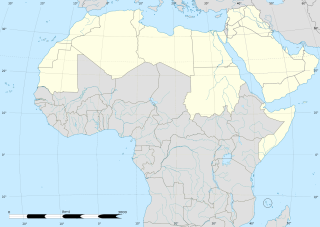
The Arab world, formally the Arab homeland, also known as the Arab nation, the Arabsphere, or the Arab states, comprises a large group of countries, mainly located in Western Asia and Northern Africa. While the majority of people in the Arab world are ethnically Arab, there are also significant populations of other ethnic groups such as Berbers, Kurds, Somalis and Nubians, among other groups. Arabic is used as the lingua franca throughout the Arab world.

The state of Democracy in Middle East and North Africa can be comparatively assessed according to various definitions of democracy. According to The Economist Group's Democracy Index 2023 study, Israel is the only democratic country in the region, qualified as a "flawed democracy". According to the V-Dem Democracy indices, the Middle Eastern and North African countries with the highest scores in 2024 are Israel, Tunisia and Iraq.

The Middle East and North Africa (MENA), also referred to as West Asia and North Africa (WANA) or South West Asia and North Africa (SWANA), is a geographic region. While still referring to most of the Middle East and North Africa together, it is widely considered to be a more defined and apolitical alternative to the grouping of countries that is known as the Greater Middle East, which comprises the bulk of the Muslim world.

The U.S.–MEFTA initiative started in 2003 with the purpose of creating a U.S.–Middle East Free Trade Area by 2013.

The Council of Arab Economic Unity (CAEU) was founded by Egypt, Iraq, Jordan, Kuwait, Libya, Mauritania, Palestine, Saudi Arabia, Sudan, Tunisia, Syria, United Arab Emirates and Yemen on May 30, 1964, following an agreement in 1957 by the Economic Council of the Arab League.

The roles of women in the Arab world have changed throughout history, as the culture and society in which they live has undergone significant transformations. Historically, as well as presently, the situation of women differs greatly between Arabic speaking regions, their urban or rural population and age groups. Among other factors, these differences can be attributed to local traditions, culture and religion, women's social or legal status, their level of education, health or self-awareness. Since the 19th century, and notably through the influence of the colonization in North Africa, the Arab Renaissance in Egypt, Lebanon, and Syria, and the end of the Ottoman Empire, the social and economic changes in the Arab world have become greatly accelerated and diversified.

The Arab League or League of Arab States was founded by Egypt in 1945, has 22 members and seven observer members so far: Armenia, Brazil, Chad, Eritrea, Greece, Republic of India, Venezuela.

The Arab world consists of 22 countries located in Western Asia, Northern Africa, the Maghreb, the Horn of Africa, and the Indian Ocean. It covers a combined area of 13 million km2. It extends from Morocco in the west, southward to the Comoros, eastward to Somalia, and northward to Iraq.
The Demographics of the Middle East describes populations of the Middle East, a region covering western and northern parts of the Asian and African continents respectively.

This is a list of the competitive matches played by the Syrian football team since its inception.

The Mashriq, also known as the Arab Mashriq, sometimes spelled Mashreq or Mashrek, is a term used by Arabs to refer to the eastern part of the Arab world, located in Western Asia and eastern North Africa. Poetically the "Place of Sunrise", the name is derived from the verb sharaqa, from the sh-r-q root (ش-ر-ق), referring to the east, where the sun rises.
Amaney A. Jamal is an American scholar of Middle Eastern politics who is currently the Edwards S. Sanford Professor of Politics and Director of the Mamdouha S. Bobst Center for Peace and Justice at Princeton University. Jamal earned her bachelor's degree in politics at UCLA in 1993, followed by her PhD in political science from the University of Michigan. A Carnegie Scholar, Jamal specializes in democratization and civic engagement in the Arab world as well as Muslim and Arab civic engagement in the US. She currently directs the Workshop on Arab Political Development at Princeton University, is the principal investigator of the "Arab Barometer Project", which was awarded the Best Data set in the field of Comparative Politics in 2010, and is senior advisor on the PEW Research Center Projects focusing on Islam in America and Global Islam. Jamal has been interviewed on numerous programs throughout her career including MSNBC, Al Jazeera, and the Washington Post to discuss issues ranging from the Palestinian–Israeli conflict to politics of the Arab world at large.
The Arab sign-language family is a family of sign languages spread across the Arab Middle East. Its extent is not yet known, because only some of the sign languages in the region have been compared.
Arabs in Switzerland are Swiss citizens or residents of Arab ethnic, cultural or linguistic heritage from Arab countries, particularly North Africa, Levant, and Iraq, also small groups from Palestine, Yemen, and Sudan, who emigrated from their native nations and currently reside in Switzerland.

The Second Arab Spring is a series of anti-government protests which took place in Algeria, Egypt, Iraq, Jordan, Lebanon, Libya, Morocco, Oman, Sudan, Syria and Tunisia, with several starting in late 2018. Economic protests also took place in the Gaza Strip.
The demographics of the Middle East and North Africa (MENA) region show a highly populated, culturally diverse region spanning three continents. As of 2022, the population was around 493 million. The class, cultural, ethnic, governmental, linguistic and religious make-up of the region is highly variable.

Climate change in the Middle East and North Africa (MENA) refers to changes in the climate of the MENA region and the subsequent response, adaption and mitigation strategies of countries in the region. In 2018, the MENA region emitted 3.2 billion tonnes of carbon dioxide and produced 8.7% of global greenhouse gas emissions (GHG) despite making up only 6% of the global population. These emissions are mostly from the energy sector, an integral component of many Middle Eastern and North African economies due to the extensive oil and natural gas reserves that are found within the region. The region of Middle East is one of the most vulnerable to climate change. The impacts include increase in drought conditions, aridity, heatwaves and sea level rise.
The Federation of Arab News Agencies (FANA), a branch of the Arab League, is a membership organization for Arabic-language, national news agencies, currently of 18 or 19 members and established in 1975 in Beirut, Lebanon.












